高考英语作文话题三中国传统节日介绍 精品 PPT课件
- 格式:ppt
- 大小:221.50 KB
- 文档页数:7
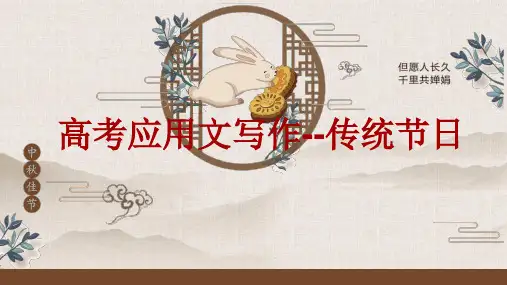
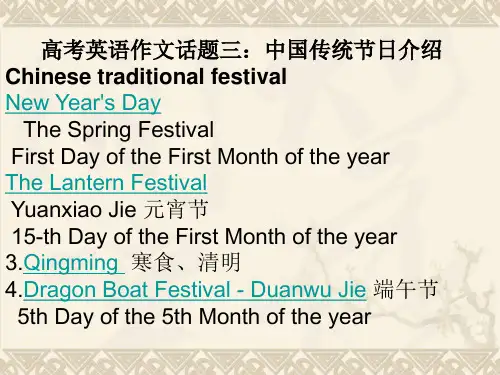

The Magic of the Spring Festival: A CulturalCelebrationAs the winter chill slowly gives way to the warmth of the sun, the air is filled with excitement and anticipation. This is the time of year when families gather together, hearts are filled with joy, and the spirit of celebration fills the air. It is the Spring Festival, a time of renewal, reflection, and togetherness—a cultural celebration that has been a part of the Chinese heritage for generations.Known as the Chinese New Year, the Spring Festivalmarks the beginning of a new lunar year and is a time for reflection on the past year and aspirations for the year ahead. It is a festival of colors, sounds, and flavors—a vibrant display of red lanterns, fireworks, and the aromaof traditional dishes filling the air.The preparations for the festival begin weeks before,as families clean their homes to sweep away any traces ofthe past year's misfortunes and make way for new blessings. This cleaning, known as "sweeping the dust," is a symbolic act that represents purging negativity and welcomingpositive energy.As the festival approaches, families gather together, often traveling long distances to be with their loved ones. The reunion dinner, known as "nian ye fan," is a highlight of the celebrations. This meal is a feast of traditional dishes, each with its own symbolic meaning. Fish, for instance, represents abundance, while dumplings symbolize wealth.One of the most enchanting aspects of the Spring Festival is the exchange of red envelopes, known as "hongbao." These envelopes, usually filled with money, are given to children and unmarried individuals as a symbol of good luck and prosperity. The vibrant red color of the envelopes is believed to ward off evil spirits and bring good fortune.The festival is also marked by an array of traditional activities, such as watching dragon and lion dances,setting off fireworks, and paying visits to temples to pray for a prosperous new year. These activities create afestive atmosphere that fills the air with joy and excitement.The Spring Festival is not just a time for celebration, but also a time for reflection. It is a reminder to honor our ancestors, to value family ties, and to appreciate the blessings of the past year. It is a time to give thanks for the opportunities and challenges that have shaped us and to embrace the opportunities that lie ahead.As the festival comes to an end, the spirit of celebration remains. The Spring Festival is not just a cultural celebration; it is an embodiment of the Chinese spirit—a spirit of unity, hard work, and hope. It is a reminder that through unity and hard work, we can overcome any challenges and create a brighter future for ourselves and our loved ones.**春节的魔力:一场文化盛宴**随着冬日严寒逐渐让位于太阳的温暖,空气中充满了激动和期待。
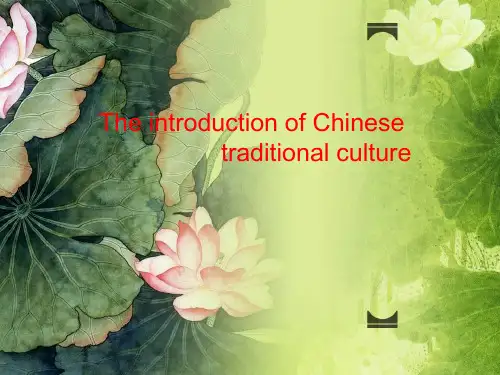
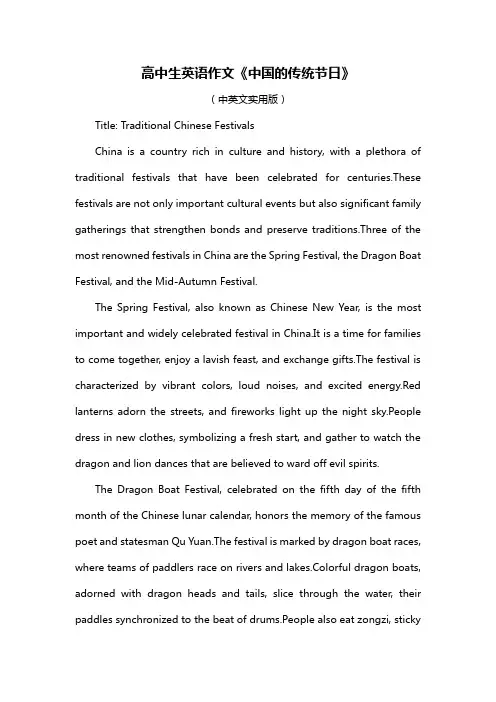
高中生英语作文《中国的传统节日》(中英文实用版)Title: Traditional Chinese FestivalsChina is a country rich in culture and history, with a plethora of traditional festivals that have been celebrated for centuries.These festivals are not only important cultural events but also significant family gatherings that strengthen bonds and preserve traditions.Three of the most renowned festivals in China are the Spring Festival, the Dragon Boat Festival, and the Mid-Autumn Festival.The Spring Festival, also known as Chinese New Year, is the most important and widely celebrated festival in China.It is a time for families to come together, enjoy a lavish feast, and exchange gifts.The festival is characterized by vibrant colors, loud noises, and excited energy.Red lanterns adorn the streets, and fireworks light up the night sky.People dress in new clothes, symbolizing a fresh start, and gather to watch the dragon and lion dances that are believed to ward off evil spirits.The Dragon Boat Festival, celebrated on the fifth day of the fifth month of the Chinese lunar calendar, honors the memory of the famous poet and statesman Qu Yuan.The festival is marked by dragon boat races, where teams of paddlers race on rivers and lakes.Colorful dragon boats, adorned with dragon heads and tails, slice through the water, their paddles synchronized to the beat of drums.People also eat zongzi, stickyrice dumplings wrapped in bamboo leaves, which are believed to prevent evil spirits from entering the home.The Mid-Autumn Festival, also known as the Moon Festival, is one of the most romantic festivals in China.Celebrated on the 15th day of the eighth lunar month, it falls during the full moon when the weather is cool and clear.Families gather to admire the full moon, share mooncakes, and tell stories about the moon.The festival is a time for couples to express their love and for families to wish for unity and nterns of various shapes and colors are lit up, adding a magical touch to the night.These festivals are not just excuses for a holiday but are deeply rooted in Chinese culture and heritage.They bring people together, fostering a sense of community and continuity.Through these festivals, China's rich and diverse history is passed down from generation to generation, ensuring that their cultural heritage remains alive and celebrated for years to come.。

Festive Revelry: The Mid-Autumn Festival inChinaLadies and Gentlemen,Today, I am honored to take you on a journey through one of China's most enchanting and culturally rich traditions - the Mid-Autumn Festival. This festival, deeply rooted in ancient lunar calendars and legends, embodies the essence of family, unity, and celebration.The Mid-Autumn Festival, also known as the Mooncake Festival or the Reunion Festival, falls on the 15th day of the 8th month of the lunar calendar, when the moon is atits fullest and brightest. It is a time for family members to gather together, much like Thanksgiving in the West, but with a unique focus on moon gazing and the appreciation of nature.The festival's origins are shrouded in mythology, with the most popular story being that of Chang'e, the Moon Goddess. According to legend, Chang'e ascended to the moon after drinking an elixir of immortality, leaving her beloved husband behind. Her loneliness and sorrow are saidto be the reason why the moon appears so bright and round on this day, a symbol of her longing for her husband.Mooncakes are the hallmark of this festival. These round pastries, symbolizing completeness and reunion, are shared among family members. Mooncakes are not just food; they are a symbol of love, hope, and togetherness. The practice of giving mooncakes to loved ones is a way of expressing affection and wishing them a bright future.Aside from mooncakes, other traditional activities include lantern lighting, poem reading, and dragon dance performances. Lanterns of various shapes and sizes are displayed, each carrying a unique symbol or message. Poetry readings often center around the moon, its beauty, and the feelings it evokes. Dragon dances, vibrant and exciting, are performed to bring good luck and prosperity.The Mid-Autumn Festival is not just a time for celebration but also a time for reflection. It is a reminder of the importance of family, the value of unity, and the beauty of nature. It is a festival that transcends generations and cultural boundaries, connecting people across China and beyond.In conclusion, the Mid-Autumn Festival is a vibrant celebration of life, love, and tradition. It is a testament to the resilience and richness of Chinese culture, aculture that continues to thrive and evolve even in the face of modernization and globalization. As we gather tonight to admire the bright moon and share mooncakes, let us remember the deeper meanings of this festival: the importance of family, the value of unity, and the beauty of nature.Thank you.**中国传统节日的魅力:中秋节**各位女士们、先生们:今天,我非常荣幸能够带大家领略中国最富有魅力和文化底蕴的传统节日之一——中秋节的魅力。

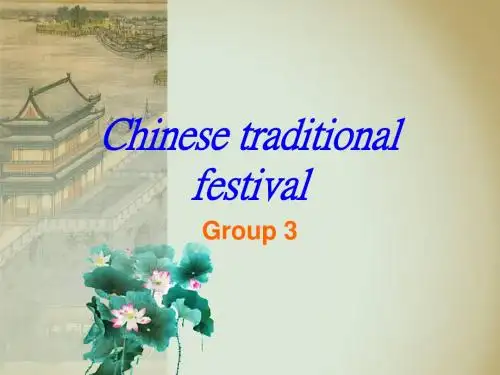
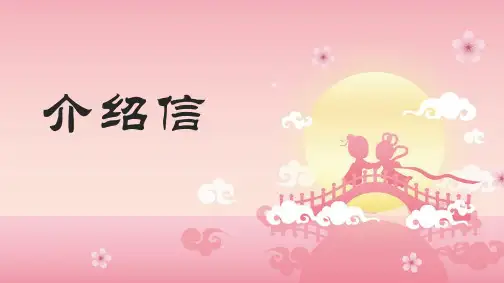
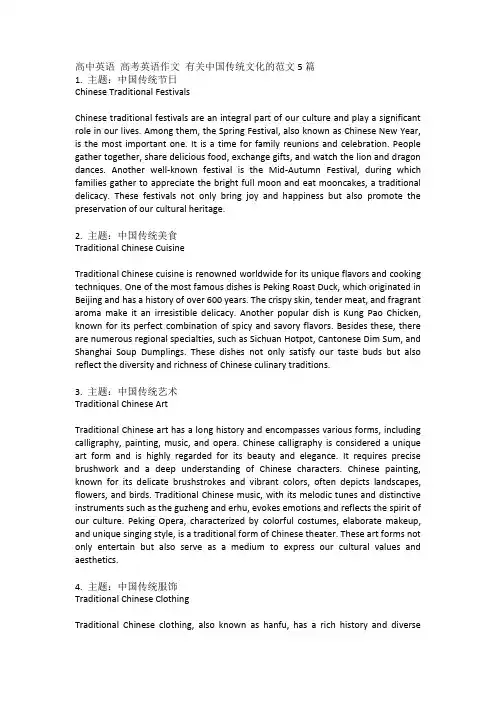
高中英语高考英语作文有关中国传统文化的范文5篇1. 主题:中国传统节日Chinese Traditional FestivalsChinese traditional festivals are an integral part of our culture and play a significant role in our lives. Among them, the Spring Festival, also known as Chinese New Year, is the most important one. It is a time for family reunions and celebration. People gather together, share delicious food, exchange gifts, and watch the lion and dragon dances. Another well-known festival is the Mid-Autumn Festival, during which families gather to appreciate the bright full moon and eat mooncakes, a traditional delicacy. These festivals not only bring joy and happiness but also promote the preservation of our cultural heritage.2. 主题:中国传统美食Traditional Chinese CuisineTraditional Chinese cuisine is renowned worldwide for its unique flavors and cooking techniques. One of the most famous dishes is Peking Roast Duck, which originated in Beijing and has a history of over 600 years. The crispy skin, tender meat, and fragrant aroma make it an irresistible delicacy. Another popular dish is Kung Pao Chicken, known for its perfect combination of spicy and savory flavors. Besides these, there are numerous regional specialties, such as Sichuan Hotpot, Cantonese Dim Sum, and Shanghai Soup Dumplings. These dishes not only satisfy our taste buds but also reflect the diversity and richness of Chinese culinary traditions.3. 主题:中国传统艺术Traditional Chinese ArtTraditional Chinese art has a long history and encompasses various forms, including calligraphy, painting, music, and opera. Chinese calligraphy is considered a unique art form and is highly regarded for its beauty and elegance. It requires precise brushwork and a deep understanding of Chinese characters. Chinese painting, known for its delicate brushstrokes and vibrant colors, often depicts landscapes, flowers, and birds. Traditional Chinese music, with its melodic tunes and distinctive instruments such as the guzheng and erhu, evokes emotions and reflects the spirit of our culture. Peking Opera, characterized by colorful costumes, elaborate makeup, and unique singing style, is a traditional form of Chinese theater. These art forms not only entertain but also serve as a medium to express our cultural values and aesthetics.4. 主题:中国传统服饰Traditional Chinese ClothingTraditional Chinese clothing, also known as hanfu, has a rich history and diversestyles. The traditional clothing for women often features flowing silk robes with vibrant colors and intricate embroidery. The qipao, a form-fitting dress with a high collar and slits on the sides, is another iconic traditional garment. For men, the traditional attire includes robes with wide sleeves and embroidered designs. The tangzhuang, a traditional Chinese suit, is a popular choice for formal occasions. These traditional garments not only reflect our cultural heritage but also showcase the elegance and grace of Chinese fashion.5. 主题:中国传统建筑Traditional Chinese ArchitectureTraditional Chinese architecture is characterized by its unique style, intricate designs, and harmonious integration with nature. The Forbidden City in Beijing, with its grand palaces and magnificent gates, is a prime example of traditional Chinese architecture. The Temple of Heaven, a masterpiece of ancient Chinese architecture, features exquisite wooden structures and beautiful gardens. The Great Wall, a world-famous architectural wonder, showcases the remarkable engineering skills of ancient Chinese people. These architectural marvels not only demonstrate our ancestors' wisdom and craftsmanship but also serve as cultural symbols and tourist attractions.。

中国传统节日国庆节:庆祝与传承**Title: Chinese Traditional Festival - National Day: Celebration and Heritage****Slide 1: Cover Page*** Title: Chinese Traditional Festival - National Day * Subtitle: Celebration and Heritage * Background: Flag of China waving with festive fireworks in the night sky.**English Content:**Welcome to our presentation on the Chinese Traditional Festival - National Day. This slideshow explores the significance, history, and celebrations associated with this important national holiday.**Chinese Content:**欢迎来到我们关于中国传统节日——国庆节的演示文稿。
本次幻灯片将探讨这个重要国家节日的意义、历史和庆祝活动。
**Slide 2: Introduction*** Title: Introduction to National Day * Content: Brief overview of National Day, its significance, and place in Chinese culture.**English Content:**National Day, also known as Guoqing Jie in Chinese, is a national holiday celebrated in China to commemorate the founding of the People's Republic of China (PRC) in 1949. It is a day of pride and unity, marked by parades, flag-raising ceremonies, and various cultural performances.**Chinese Content:**国庆节,又称“国庆节”,是中国为纪念1949年中华人民共和国成立而设立的国家节日。